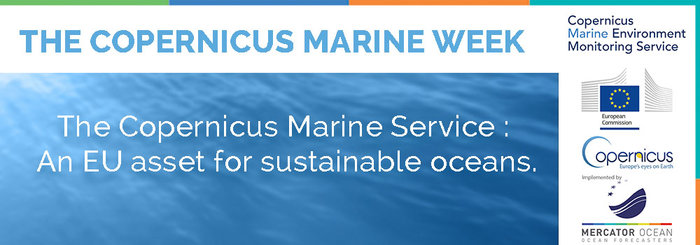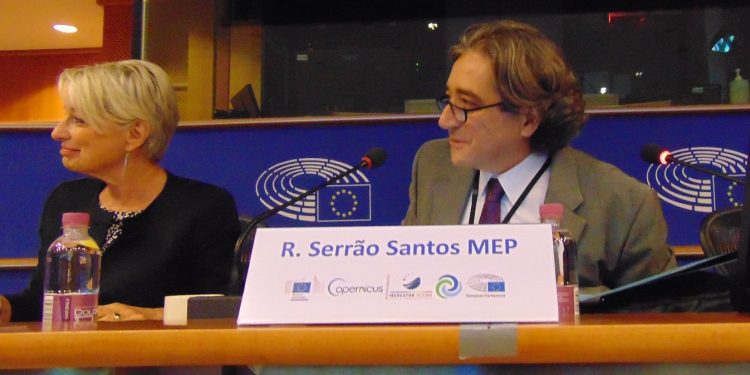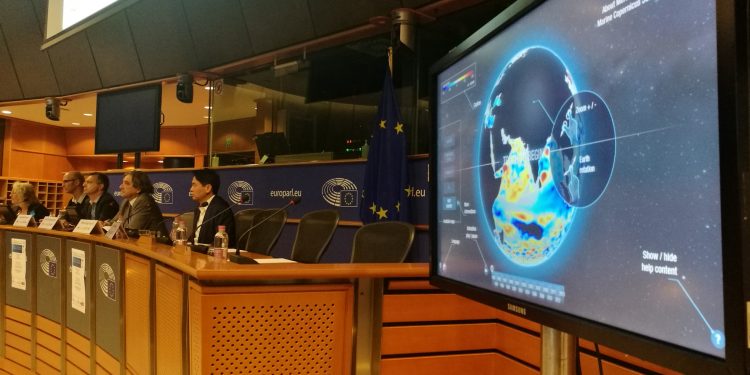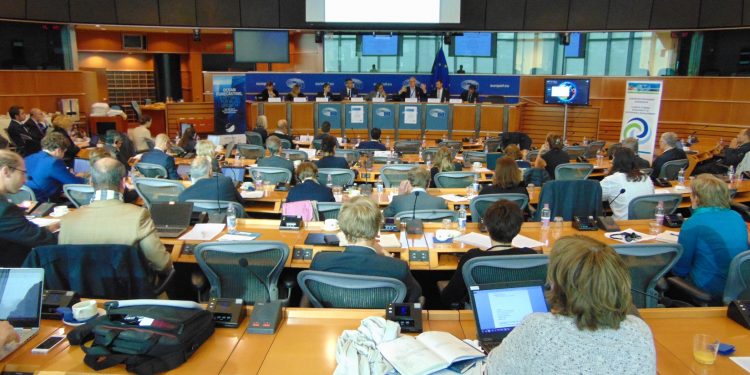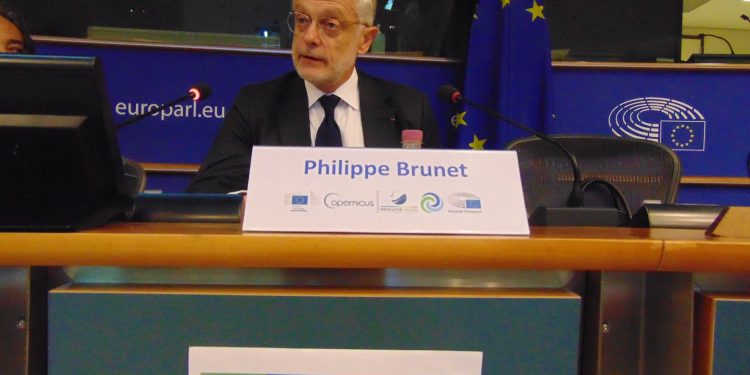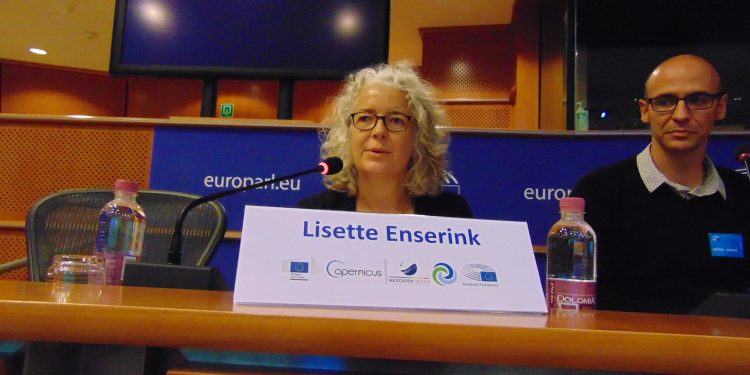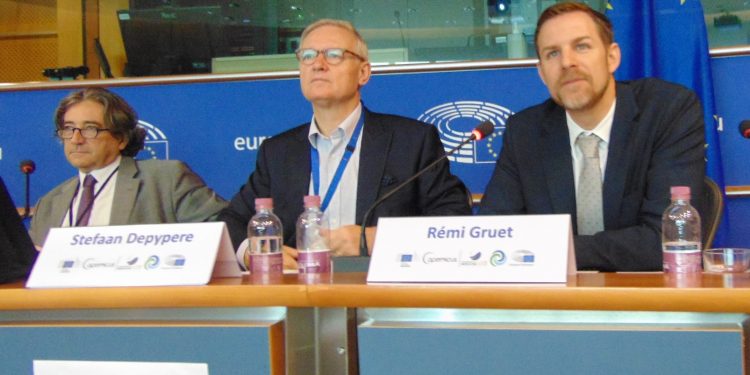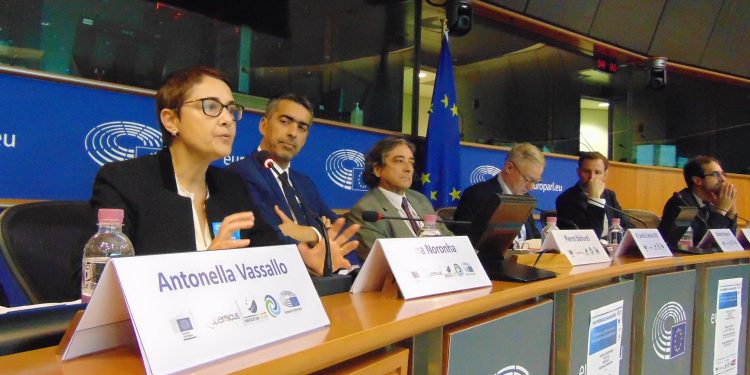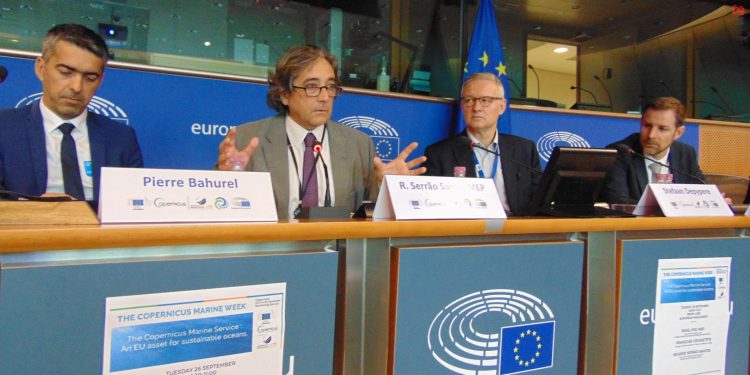Copernicus Marine Service: An EU asset for sustainable oceans
Policy-makers, research institutions, industry, environmental organisations, civil society, and stakeholders gathered in the European Parliament on 26 September 2017 to discuss the achievements and future prospects of the Copernicus Marine Environment Monitoring Service (CMEMS). The EU Copernicus programme is in the process of its mid-term evaluation review and in light of this occasion Mercator Ocean organised the Copernicus Marine Week: a week of open forum meant for discussion and debate with a wide range of stakeholders. The Copernicus Marine Week organised by Mercator Ocean together with 18 partners presented CMEMS achievements after three years of operation in order to receive feedback for improvements as well as ideas among stakeholders, where the European Parliament also plays an important role. The side event was therefore organised to showcase from one side the operational system and from another how it delivers science-based information to a variety of users through the voice of the users themselves.
Françoise Grossetête MEP welcomed participants by highlighting that 2017 has been an important year for the European space sector showcasing its importance for the future of the EU. The space sector allows the EU to be an accelerator of knowledge in many different fields and affects public policies such as environment, marine, defence, agriculture etc. It was stressed that there are many possibilities to offer particularly mentioning the importance of SMEs as they are at the forefront of making use of spatial data and for the development of Copernicus. The European Parliament has provided continuous support for the development of the Copernicus programme, in particular in the Parliament’s report on the space strategy that was recently adopted. It was said that the programme contributes to many objectives that we wish to achieve such as combating marine pollution, ensuring maritime safety, reducing greenhouse gas emissions, and protecting biodiversity, to name a few. It was said that CMEMS is gaining momentum and benefiting our economy as well as research, innovation, jobs, and environment. This will however require an ambitious budget as well as training for Europeans.
Ricardo Serrão Santos MEP and Chair of the working group on “Biodiversity and Ecosystem Services” of the EP Intergroup on “Climate Change, Biodiversity, and Sustainable Development” outlined the programme for the conference and highlighted that the CMEMS is an international and operational oceanography service, which provides regular and systematic information about the physical state and dynamics of the oceans and marine ecosystems for the global ocean and the EU regional seas on a free and open base. It was said that in 2014 the European Commission decided to entrust Mercator Ocean with its implementation also underlining the importance for international cooperation in achieving this. The importance of CMEMS was raised in particular with regards to recent extreme weather events and the role it can play in hurricane forecasting.
Philippe Brunet, Director “Space Policy, Copernicus and Defence”, DG GROW, European Commission outlined that the Copernicus programme was adopted three and a half years ago and has since then become fully operational already showcasing its multiple benefits such as job creation and boosting the economy. It was said that the first step has been reached with the data collected, which is valuable and contains multiple dimensions. It was for instance mentioned how CMEMS products could be of support forecasting and following the development of certain extreme weather events, as recently by analysing the ocean temperature evolution during hurricane Irma. Further, Copernicus is a significant tool facilitating decision-making at EU, national, and local level while also helping businesses and stakeholders. It was emphasised that the data collected is free and openly accessible to benefit the European market. It was informed that the Commission will in the first semester of 2018 launch distribution platforms to increase provisions and processing of data. Copernicus is not only a key player in the development of space servicing the economic and scientific needs but also a pool of excellence to meet environmental challenges. It was concluded by emphasising that continuous funding will be crucial and that there is potential for further applications mentioning using the programme to track the implementation of the Paris Agreement.
Pierre Bahurel, CEO Mercator Ocean underlined in his presentation that CMEMS provides regular and systematic reference information on the state and the environment of the ocean and the European seas. Products, delivered on a fully free and open base, refers to physics variables e.g. temperature, currents, wind, and sea ice, and to biogeochemical variables e.g. oxygen, nitrates and production to name a few. The products are available for the present (real time), the past (re-analyses) and for the future (forecasts) as observation data or model products: everything is available on a web portal and accessible to all. The data is collected via satellite as well as sea borne measurements (in situ). Entrusted by the EU to implement and operate CMEMS, Mercator Ocean run the service together with the so called “Copernicus Marine Community”: a series of pan-European public and private institutions responsible for the different functionalities of the service. It is nowadays possible to describe and simulate the ocean on a 3D and 4D dimension: latitude, longitude, depth and in time. As part of the Copernicus Marine Community, relevant entities have a partnership with Mercator Ocean for specific tasks like collecting the in situ data necessary for the service, those entities being the European Environmental Agency and EuroGOOS. There are now more than 10 000 CMEMS subscribers, and the aim is not only to further support them but as well to encourage potential users. It was informed that the Copernicus Marine Week will provide the opportunity to evaluate the service’s achievements, contributions, and future plans to ensure better impact for its users. It was concluded by stating that CMEMS is a great example of how information is an integral part of accelerating a growth economy.
Panel 1 – User testimonies
Lisette Enserink, Netherlands Rijkswaterstaat and Dimitry Van Der Zande, RBINS presented the EU project “Joint monitoring and assessment of eutrophication in the North Sea with satellite data” (JMP-EUNOSAT). Ms. Enserink outlined in the presentation that the project is supported by DG ENV and is part of the implementation of the Marine Strategy Framework Directive (MSFD) aiming particularly to improve monitoring and assessment of eutrophication, which is an important aspect of water quality, in the North Sea. It is a 2 year project, which started in February 2017 and includes 14 partners in all countries bordering the North Sea responsible for monitoring and assessment. The challenge faced is to assess eutrophication from national to North Sea scale. In order to move to a larger scale coherence between countries is essential. Availability of remote sensing data was also mentioned as a driver for change as well as the need to keep the costs of monitoring low. The project can also learn from other similar executed projects such as the assessment of eutrophication in the Baltic Sea. The activities in the project currently range from data collection to assessment and organisation and coordination of collaboration as well as communication. Mr. Van Der Zande further highlighted the example of Belgium and RBINS who have been working on satellite-based ocean colour products, which provide information on the quality of the water in terms of chlorophyll content. It was said that such information provides further insights on what is happening with the oceans also underlining that it does not take into account national borders. It was explained that daily snapshots have been taken of the North Sea in order to transform them into consultation measures to be used. This has also provided an idea of how the phytoplankton dynamics are working and whether it should be implemented into an operational user scheme, which would require validation or comparing it to traditional data. It was said that once the optimal satellite product is established it can be assessed with regards to the good environmental status. It is planned to upscale this Belgian approach to North Sea level. This is however not straightforward due to varying types of water and the need to find the most suitable product in order to implement this operational service as well as compare and validate it. It was emphasised that understanding marine ecosystems is important for marine policies and management and that innovative solutions to improve monitoring in a cost effective and coherent manner are welcomed by EU Member States. It was stated that Copernicus will continue to provide satellite products creating strong support for satellite-based monitoring services like presented in the JMP-EUNOSAT project. Further, there is still a significant technical barrier to be crossed in order to push satellite products into an operational service such as MSDF monitoring, especially in coastal zones.
Jean-Noël Druon, Joint Research Centre, European Commission showed the video “Tracking Essential Fish Habitat: future fisheries management will be dynamic highlighting that oceans and fish habitats are highly dynamic but that they can be monitored by satellites, in situ observations, and ocean models with the Copernicus programme being the cornerstone of this. The JRC uses Copernicus data to identify the favourable habitats, migration patterns and potential population size of important fish species. Information on fish habitats helps scientists and policy makers to improve the robustness of fish stock estimates. Real-time maps of essential fish habitats can be projected to fishermen via smart phones helping them avoid fishing in such areas. CMEMS and JRC work together to develop operational ecology products for more dynamic and smarter management of our oceans. It was informed that real-time maps of hake nurseries in the Mediterranean Sea are available to download on the fish habitat website of the JRC. It was said that nurseries are often found near the seabed and only ocean models can provide reliable information at these depths, for instance as for hake on seabed temperature and currents. It was underlined that CMEMS therefore provides data that favours a link and a win-win situation between scientists and the fisheries sector. Further, the downstream application of key fish habitat for operational ecology is timely fisheries management. It can be useful to limit by-catch, to improve research on ecosystem modelling, to reduce uncertainties in fish stock estimates, to adapt fishing quotas to the size of the population and to monitor invasive alien species. Copernicus is central in providing useful environmental variables calling for its greater demand for practical use of science in society. It was concluded by stating that Copernicus could further deliver sound science for policy acceptance, which could be done through development and production of environmental advanced indicators to feed EU marine policies.
Thanh-Long Huynh, QuantCube Technology explained in his presentation that this start-up company was established four years ago and is specialised in big data analytics for long-term, mid-term, and short-term. It was explained that they extract and analyse data coming from various data sources such as satellite, weather, logistics, social networks etc. By applying this data and by using a large range of artificial intelligence models, real-time estimations and predictions of fundamental macroeconomic indicators can be made. It was said that these indicators can be used to optimise investments and to improve public policies and growth strategies. QuantCube Technology has a strategic partnership with Mercator Ocean and CMEMS has been very useful in accessing and utilising oceanographic data to apply its operations to maritime applications. It was underlined that there is a big market for maritime applications providing the example of the insurance sector and how to calculate internal along with external data in order to find a predictable pricing model. It was highlighted that the market for maritime has great potential. QuantCube Technology is also contributing to jobs and growth as they will continue to expand in the coming years with positions dealing with oceanographic data and applications.
Andre Abreu, Tara Expeditions highlighted in his presentation that the vessel Tara is a platform for high-level scientific research missions who depend on the environmental data provided by CMEMS. It was said that the current decade marks a period of important decisions related to governance of the ocean also emphasising the growing impact of climate change and the effects on the oceans. He remarked on the development of new technologies such as Next Generation Sequencing, Big Data analysis, robots, satellite sensors, bioinformatics and bioimaging that have resulted in an evolution in ocean observation to real time remote sensing and genomics. This genomic analysis in marine biology in particular has become increasingly possible due to decreasing costs in DNA sequencing technology allowing the possibility to study the ocean genome. Further, he emphasised the need for adding biological parameters into oceanographic research by highlighting the success Tara Expeditions has achieved in integrating environmental data with imaging data and genomics data, to further understand the impacts of climate change. In looking towards the future he pointed out the need for advancing these existing data resources and infrastructure as well as building on cross-disciplinary standards to improve overall monitoring of the oceans. In addition, ocean data and bioimaging are essential in order to further research the carbon pump and understand better the effects of climate change. It was concluded by highlighting that oceans need to be further connected to the climate change agenda.
The discussion with the audience praised the users and the examples provided of CMEMS products. When looking to the evolution of CMEMS it was asked what would be the most pressing needs for its development. It was emphasised that CMEMS can support policy as well as the broader community of users. It was said that for the management of marine environment and policy-making, maps are very important and provide a great advantage of CMEMS products. With regards to the JMP-EUNOSAT project it was said that by using the products they have been able to test how fit for purpose they are and will be able to feed back to the Copernicus community on some of the challenges they faced, which will ultimately improve the quality of the data. Panellists also highlighted that the access of the data is useful and gives users a competitive edge particularly for businesses and jobs in the EU. The debate also highlighted the importance of marine data and that in the case of conflicting data appearing to somehow be addressed. With regards to big data it was reiterated that it plays a crucial role in both financial and public institutions as analyses can help provide real-time economics.
Panel 2 – “ CMEMS, an EU asset for our Blue Planet? Prospects and Challenges? ”
Damien Perissé, Conference of Peripheral Maritime emphasised that CPMR brings together around 150 regions from 24 states from the EU and beyond. The data provided by CMEMS is very important for regions in order to determine their public policy particularly with regards to the environment. It was said that various data sets are used differing in the regions, ranging from coastal protection and the fight against climate change phenomena, the analysis of the development of erosions and sediments, visualisation of human activities on costal zones to tracking endangered species like turtles. Use is however limited by the powers of the relevant authorities and competencies of each stakeholder. It was said that the EU must ensure that data is available at a lower cost and improve interoperability between ERDF and Interreg funding. CPMR is involved in the DG MARE-Coastal Mapping project, which aims at investigating what Europe could do to improve access and efficiency of the usage of the data. It was recommended to issue a European strategy for data collection also making better use of the ERDF funds for data collection.
Stefaan Depypere, Director “International Ocean Governance and Sustainable Fisheries”, DG MARE, European Commission highlighted the importance of governing the ocean and the role that the EU is playing in this, which has been laid down in the Communication on International ocean governance: an agenda for the future of our oceans. Three main actions were highlighted: work on the framework, reduce human pressure on the oceans, and develop knowledge of the oceans. The final action applies to CMEMS as it must ensure that the tools are there to collect, process, and convey data as well as make it available. The CMEMS is an important tool also mentioning EMODnet, which works to unlock data sets across Europe making them available to a large set of users. It was underlined that data and statistics are needed in order to have better scientific decision-making. Various organisations worldwide as well as Nation States have praised the data from CMEMS also underlining that CMEMS offers a public good as its data is free and accessible to all. It was reiterated that it is an essential service, which is highly appreciated. However, it was underlined that it is not sufficiently well known in Europe and that further awareness is needed in order to better connect with possible users.
Rémi Gruet, Ocean Energy Europe informed in his presentation that they represent five ocean technologies: tidal stream, wave, tidal range, ocean thermal energy conversion and salinity gradient, which are very different technologies but all make use of the ocean. The uses vary in different regions of Europe. The organisation is composed of various companies, universities, and test centres across the world with many already using CMEMS. It was underlined that ocean energy offers great potential and it is predicted by 2050 that 10% of EU electricity will come from the ocean. The different technologies will need the information and data that Copernicus is providing as well as finances in order to further develop its potential. It was also informed that European companies are already present on export markets and that CMEMS is essential in providing data that is needed in order to make these technologies successful. It was said that Copernicus offers various benefits such as free and accessible information as innovation is expensive enough. Other benefits include covering gaps in existing data, provide downloads for modelling, provides a long time vision as well as a real time vision, and helps ensure the predictability needed for renewables. In order to fully use the energy from the ocean data is crucial in assisting where to place the devices for production. CMEMS also helps with weather forecasting, which is essential for installation and maintenance of such devices. For the future it was said that CMEMS should map the resource with more data points as well as provide data closer in order to cover more potential sites. Further, CMEMS could also help with export markets as it was said that there is a low availability of information in third countries.
Jeremie Maillet, VP Marine, Alcatel Submarine Networks MARINE explained that 99% of broadband traffic is from underwater submarine technology. The oceans are covered by a network of fiberoptics transporting data across the world. It was explained that the organisation has four main markets with telecom and data being the largest one. They also work with the oil and gas industry to connect offshore assets, develop solutions for security and defence as well as maintain the highway of data. It was said that the market is constantly growing with many international players. Further, the next cycle of industry will be located in the Pacific and Asian regions also noticing new investments from the east of Africa. A system is also currently being installed in Alaska and a project is ongoing in Fiji linking the network to small pacific islands. In 2009 a high-speed optical cabling link called NEPTUNE on the west coast of Canada was installed to facilitate the flow of information through the ocean while also collecting information about the ocean. Another example mentioned is the Ellalink project, which will connect Europe and Brazil. It was underlined that Brazilian Universities are waiting for the installation of this in order to be able to use data provided by CMEMS. The industry uses intermediate satellite information from CMEMS to help with daily operations, planning and modelling the current surface and currents, and weather conditions. It was said that the data helps the industry to be more efficient. It was concluded by stating that building an accurate global sea bottom imagery would be a huge step forward for their industry and is something to be recommended for the future.
Antonella Vassallo, International Ocean Institute highlighted that the greatest threat to our oceans is ignorance, which also exemplifies the mission of the International Ocean Institute (IOI). She highlighted the history of this organization, founded in 1972 following the U.N. Convention on the Law of the Sea, as a response to the perceived needs for capacity development and training. Beginning with the assumption that the best decision are made on the best available scientific knowledge, she stressed that there is a synergy between taking the available information related to oceans, and transmitting it to potential users. It was said that the IOI provide a multitude of global training courses on the world’s oceans, and international ocean governance. It was found that the users of these courses are to be the ocean leaders of tomorrow and remarked that they are in need of the kind of information Copernicus produces. Considering the organization’s alumni network of several thousand people who have become responsible for ocean related decision taking, she stressed that it is critical that these people are fully educated and aware of the available data and how to use it in order to provide effective ocean governance. She concluded by emphasising the organisation’s strengths in the areas of outreach and promoting ocean literacy.
Ana Noronha, Ciência Viva introduced her organisation; a nonprofit dedicated to promoting scientific culture and awareness and improving contact between science and society, by hosting a network of twenty science centers across Portugal. The ocean has been a key focus of the organisation since its founding, primarily due to the relevance of ocean literacy in Portugal. She stressed that satellite images can serve an educational purpose in this area, believing that such images can bring knowledge; they can help people understand how the ocean works, and how important it is for society. She remarked on their objectives of initiating an educational dialogue on ocean satellite images by bringing them to science centers and providing teachers with resources that they can understand and interpret. She then further highlighted the goals of the organisation, which include expanding the science centers to include topics of climate change, and improving their educational platforms to incorporate multidimensional information that can be used in the class room. She stated that in order to achieve their goals of promoting ocean literacy they need an open science that is an open science also for the society, meaning scientific information not only that can be shared among scientists but also adapted to be understood by policy makers, teachers, students, and society as a whole.
The discussion with the audience further reiterated its support to CMEMS and the work of Mercator Ocean. Looking forward it was asked how to further expand and continue to work of mapping the oceans particularly mentioning the Polar Regions and what observational needs should be addressed. It was said that the Polar Regions are a critical part of the ecosystem and more information is needed on what is happening in these areas also due to their fragility. The Commission’s Arctic Strategy was also mentioned providing more attention to these regions. The need to also link the correct governance and decision-making was raised particularly when it comes to contentious and fragile areas. It was informed that feedback is currently being collected from users and this will be essential in moving forward. The need to deliver sound science for policy acceptance was raised also asking what is needed to ensure that such science is used and taken into consideration. The importance of advocacy was mentioned, stating that is easier to push for something once you have the established data and analysis, making it difficult for people to act against it. The discussion also raised the need to ensure the services and quality control within CMEMS. It was reiterated that the CMEMS is at its mid-term review taking into account the feedback mentioned here today to further improve.
Ricardo Serrão Santos MEP and Chair concluded the conference by reiterating the importance that the Copernicus programme plays for society and particularly CMEMS for the marine environment. Providing open and accessible data for all has a significant role in the various interest groups heard from today. The Copernicus programme needs to be further promoted as it is not yet well known across Europe, needing to further connect with society and ensure that its full potential is utilised.



